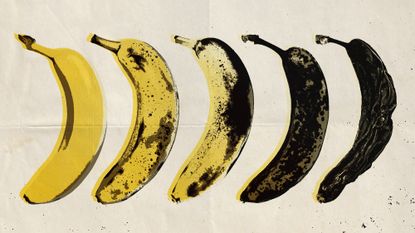Bananas have been facing extinction. But maybe not for much longer.
Scientists may have a solution for a longstanding fungus problem


The bananas we know and love have been at risk of extinction from a fungal disease. The good news is that scientists may have found a way to save them, according to a study published in the journal Nature Microbiology. The researchers isolated genes within the fungus that may be contributing to the disease's deadliness. Even with an avenue for controlling the disease, crop diversity could further reduce the fungus' virulence.
A banana bind
Bananas are being infected by a disease called Fusarium wilt of banana (FWB), caused by a fungal pathogen called Fusarium oxysporum TR4. This is not the first time a banana species has succumbed to the disease and gone extinct.
Today, the main variety of bananas bred and sold is the Cavendish, however, this species was only bred after the Gros Michel was wiped out by a previous version of the fungus called Fusarium oxysporum race 1. "The Cavendish variety was bred to be a disease-resistant replacement for the Gros Michel," said Popular Science. "This worked for a while, but by the 1990s, there was another outbreak of banana wilt that spread from Southeast Asia to Central America."
Subscribe to The Week
Escape your echo chamber. Get the facts behind the news, plus analysis from multiple perspectives.

Sign up for The Week's Free Newsletters
From our morning news briefing to a weekly Good News Newsletter, get the best of The Week delivered directly to your inbox.
From our morning news briefing to a weekly Good News Newsletter, get the best of The Week delivered directly to your inbox.
While bananas are facing the same variety of fungus, the TR4 species "did not evolve from the race that decimated the Gros Michel bananas," Li-Jun Ma, the senior author of the study, said in a press release. This new variety of the Fusarium fungus contains accessory genes "linked to the production of nitric oxide, which seems to be the key factor in TR4's virulence." The gas is toxic to the Cavendish banana. "This sudden burst of toxic gases facilitates infection by disarming the plant's defense system," Ma said in a piece for The Conversation.
Researchers were also able to determine that the intensity of TR4 was "greatly reduced if the two genes that control nitric oxide production were eliminated," said the press release. "Identifying these accessory genetic sequences opens up many strategic avenues to mitigate, or even control, the spread of Foc TR4," study lead author Yong Zhang said in the release. More research needs to be done to "better understand how the fungus can produce such a harmful gas without hurting itself," and to "test various ways to interrupt the production of nitric oxide and explore genes that can take the gas away before it damages plant cells," said Popular Science.
Diversify the banana breeds
The biggest problem crops like the banana are facing is the overwhelming prevalence of one breed. "When there's no diversity in a huge commercial crop, it becomes an easy target for pathogens," Ma said. Cavendish bananas are not the only existing variety of the fruit, but because of their popularity, they are bred in much larger numbers than others. In reality, planting a variety of different types of bananas creates more sustainable agriculture as well as makes diseases more difficult to spread rapidly.
The public can also play a role in encouraging more diverse agricultural practices by opting to buy different varieties of fruits and vegetables as well as supporting local produce species. "Collaboration among scientists, farmers, industry and consumers around the world can help avoid future shortages of bananas and other crops," Ma said in The Conversation.
Create an account with the same email registered to your subscription to unlock access.
Sign up for Today's Best Articles in your inbox
A free daily email with the biggest news stories of the day – and the best features from TheWeek.com
Devika Rao has worked as a staff writer at The Week since 2022, covering science, the environment, climate and business. She previously worked as a policy associate for a nonprofit organization advocating for environmental action from a business perspective.
-
 The week's best photos
The week's best photosA helping hand, a rare dolphin and more
By Anahi Valenzuela, The Week US Published
-
 Today's political cartoons - August 30, 2024
Today's political cartoons - August 30, 2024Cartoons Friday's cartoons - seasoned vets, football season, and more
By The Week US Published
-
 'Harris gains slim lead'
'Harris gains slim lead'Today's Newspapers A roundup of the headlines from the US front pages
By The Week Staff Published
-
 The Arctic is a ticking 'mercury bomb'
The Arctic is a ticking 'mercury bomb'An icy prison break is on the way
By Devika Rao, The Week US Published
-
 Homeowners are getting burned by solar panel scammers
Homeowners are getting burned by solar panel scammersIn Depth One-star reviews for solar companies have increased over 1,000% since 2018
By Justin Klawans, The Week US Published
-
 China's winning battle against desertification
China's winning battle against desertificationUnder The Radar Beijing is using solar power to lead the fight as climate change intensifies the threat
By Chas Newkey-Burden, The Week UK Published
-
 11 looming climate tipping points that imperil our planet
11 looming climate tipping points that imperil our planetThe Explainer New reports detail the thresholds we may be close to crossing
By Devika Rao, The Week US Published
-
 Iceberg A23a is taking a spin
Iceberg A23a is taking a spinUnder the Radar As the iceberg turns, so too does its effect on the neighboring ecosystem
By Devika Rao, The Week US Published
-
 The world's largest tropical wetland is on fire, and under threat from waterway
The world's largest tropical wetland is on fire, and under threat from waterwayUnder the Radar Proposed shipping route through Pantanal in Brazil could dry out biome and worsen devastating wildfires
By Harriet Marsden, The Week UK Published
-
 Why lithium mining has Serbians up in arms
Why lithium mining has Serbians up in armsUnder the Radar Balkan nation has reinstated controversial licence to extract 'white gold' as race for crucial EV mineral intensifies
By Harriet Marsden, The Week UK Published
-
 The Great Salt Lake is getting less great by the year
The Great Salt Lake is getting less great by the yearUnder the radar Evaporation is wrecking havoc on the local ecosystem
By Devika Rao, The Week US Published